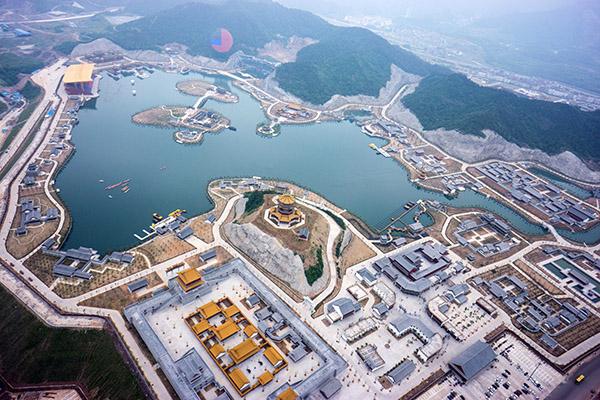
The New Yuanmingyuan Park opened in Dongyang, Zhejiang province on May 10. A local enterprise funded the project, which copies 95 percent of the buildings of the Yuanmingyuan imperial park, or Old Summer Palace, in Beijing. The palace was looted and then burned by Anglo-French forces in 1860 during the Second Opium War (1856-60).[Photo/Provided to China Daily]
The controversial replica of the Old Summer Palace, or Yuanmingyuan, Beijing’s renowned garden complex that was looted by British and French troops in 1860, opened its gates on May 10 in Dongyang, Zhejiang province.
The New Yuanmingyuan Palace cost 30 billion yuan ($4.8 billion). It covers more than 400 hectares at Hengdian World Studios, China’s largest outdoor film studio, and claims to duplicate the former royal retreat in its original size.
The Old Summer Palace in northwest Beijing was first constructed in the early 18th century as a site to honor both the best of Chinese landscaping and Western styles.
“About a decade ago, I found some French scholars had suggested rebuilding the Old Summer Palace as atonement,” Xu Wenrong, founder of Hengdian World Studios and the initiator of the reconstruction project, said.
“Each page of history matters for today’s people. I want to present the old days’ glory to nurture patriotism among the young generation by letting them better know our ancestors’ creativity, and turn people’s sorrow to eagerness for peace.”
Construction of the replica began in 2012. Part of the park, including a replica of the Great Fountain Dashuifa, one of the best known sites at the Old Summer Palace, is still being built and will open to the public next year.
“There must be regrets building the replica, like some old construction techniques have been lost, but we used the best techniques available today to get close to history,” Xu said, admitting there had been difficulties gathering historical files and blueprints of the original structure.
It is not yet known whether the new park will be used for film production. The entrance fee will be 280 yuan per person, but Xu confidently predicts there will be 40 to 50 million visitors within five years.
Public doubts surfaced when the project was first announced in 2007. A major concern has been whether it is necessary to rebuild a destroyed site that carries sad memories for all Chinese people.
“The Old Summer Palace represents the last peak of ancient Chinese architecture, and no one is able to duplicate its original style today,” said Lyu Zhou, deputy dean of the School of Architecture, at Tsinghua University, in an interview on China National Radio in late April.
“The Old Summer Palace is important for today’s people as a record of foreign invasion. However, it lost the meaning as a garden the moment it was burned, and that meaning is irretrievable.”
The administrative office of Ruins of Yuanmingyuan Park in Beijing also recently said it may take legal action against the replica for violation of property rights.
However, Huo Zhengxin, a law professor at China University of Political Science and Law, said there is no such violation. The replica was built away from Beijing, making it impossible to directly harm the original site, he said, and the new park replicates historic buildings rather than duplicates the remains in Beijing.
Xu said: “I’m not afraid of people’s doubts, which make me more considerate in doing my work. People have different opinions about what we did in Hengdian.”
